Organisational Behaviour: Improving Team Performance and Productivity
VerifiedAdded on 2023/06/05
|15
|4664
|210
Report
AI Summary
This report delves into the complexities of organisational behaviour within Morrisons, a major UK supermarket chain, examining the influence of organisational culture, politics, and power on individual and team performance. It analyses various organisational culture types, including power, person, role, and task cultures, and their respective impacts. The report also explores organisational politics, such as self-promotion, office politics, and territorialism, and their effects on the work environment. Furthermore, it investigates different types of organisational power, including legitimate, reward, and expert power, and their potential to positively or negatively influence employee behaviour. The report evaluates content and process theories of motivation, such as Maslow's Hierarchy of Needs and Herzberg's Two-Factor Theory, as well as expectancy theory and goal-setting theory, providing insights into how Morrisons can create a more motivated workforce. Finally, it discusses the characteristics of effective teams and applies organisational behaviour concepts to improve business performance and productivity.
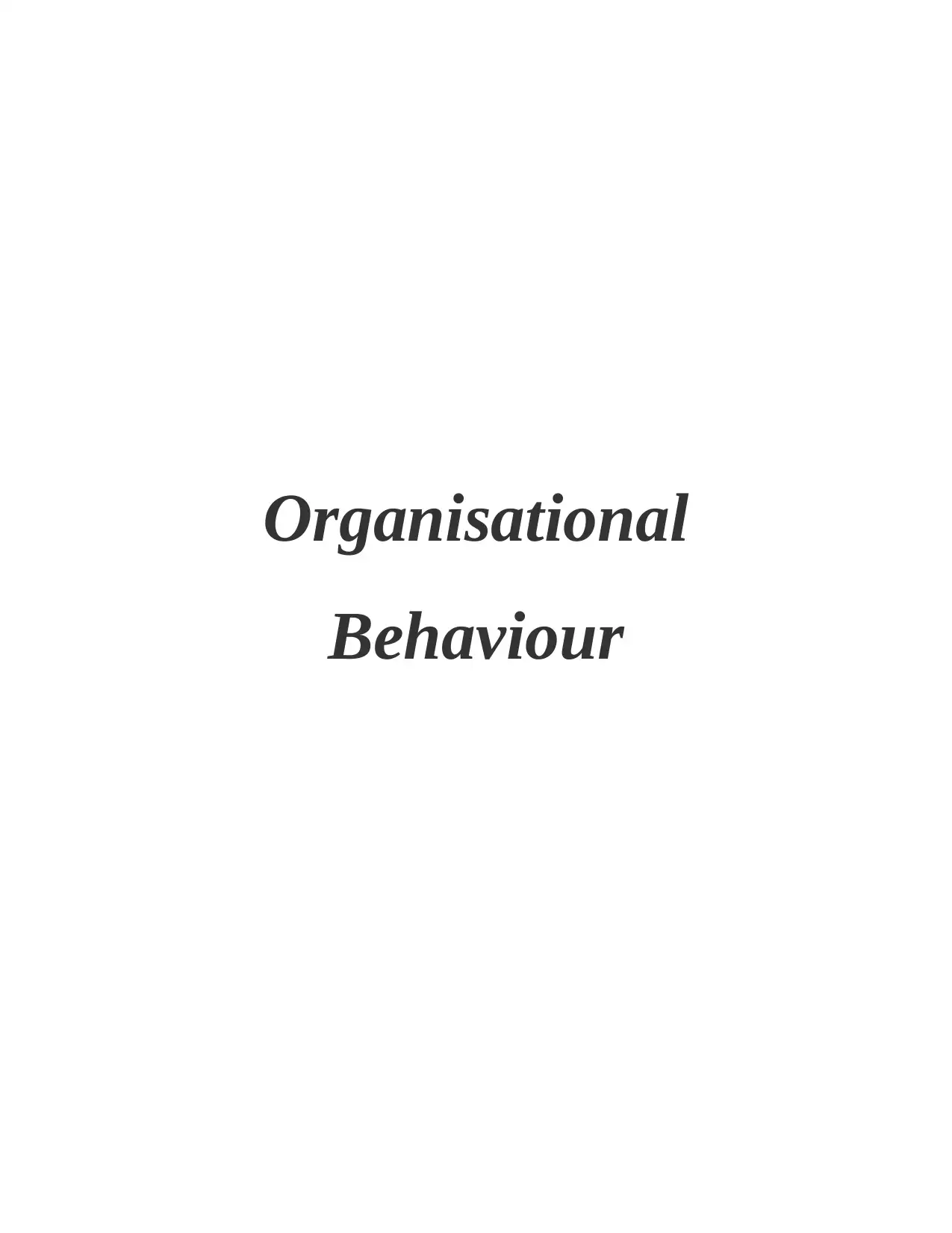
Organisational
Behaviour
Behaviour
Paraphrase This Document
Need a fresh take? Get an instant paraphrase of this document with our AI Paraphraser
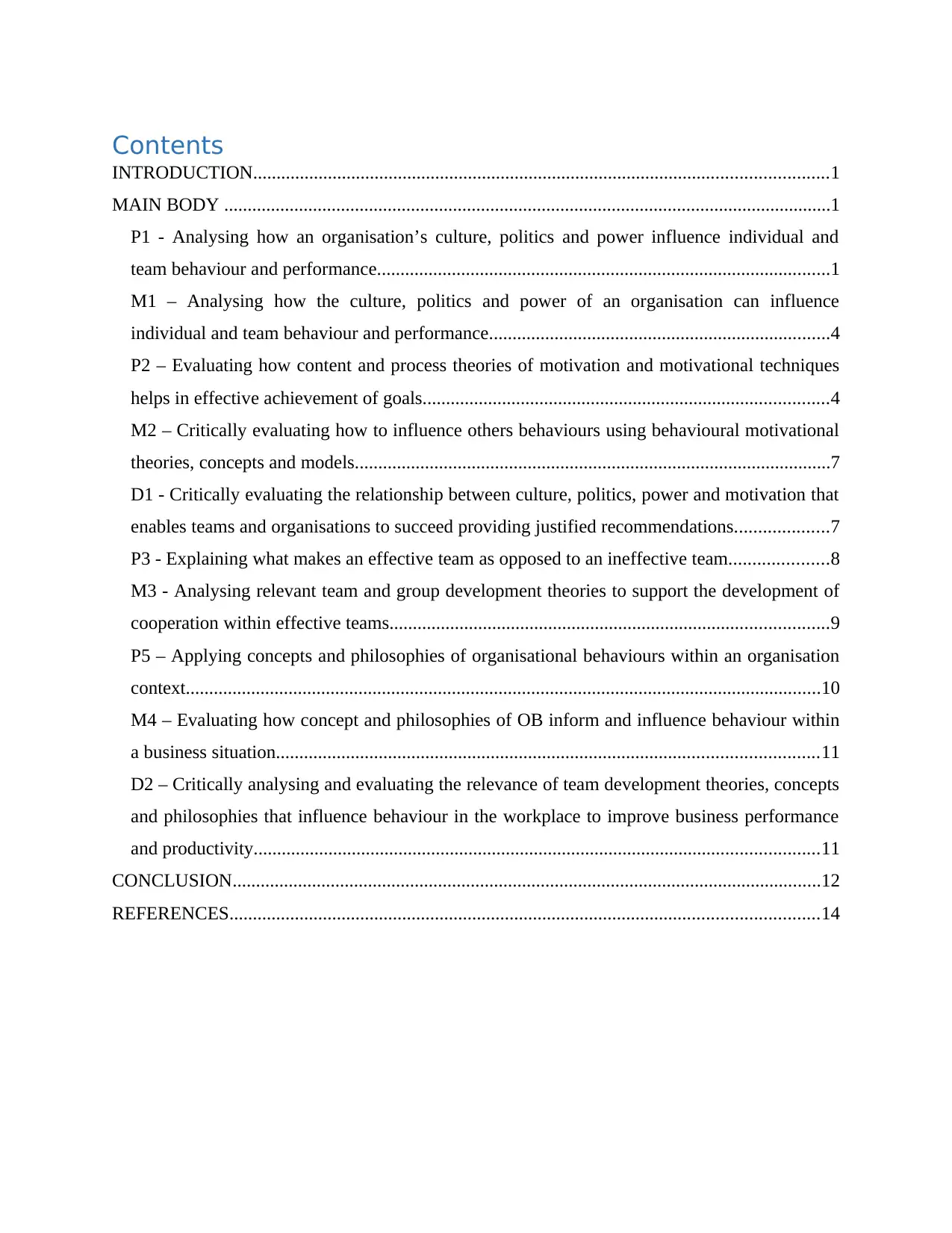
Contents
INTRODUCTION...........................................................................................................................1
MAIN BODY ..................................................................................................................................1
P1 - Analysing how an organisation’s culture, politics and power influence individual and
team behaviour and performance.................................................................................................1
M1 – Analysing how the culture, politics and power of an organisation can influence
individual and team behaviour and performance.........................................................................4
P2 – Evaluating how content and process theories of motivation and motivational techniques
helps in effective achievement of goals.......................................................................................4
M2 – Critically evaluating how to influence others behaviours using behavioural motivational
theories, concepts and models......................................................................................................7
D1 - Critically evaluating the relationship between culture, politics, power and motivation that
enables teams and organisations to succeed providing justified recommendations....................7
P3 - Explaining what makes an effective team as opposed to an ineffective team.....................8
M3 - Analysing relevant team and group development theories to support the development of
cooperation within effective teams..............................................................................................9
P5 – Applying concepts and philosophies of organisational behaviours within an organisation
context........................................................................................................................................10
M4 – Evaluating how concept and philosophies of OB inform and influence behaviour within
a business situation....................................................................................................................11
D2 – Critically analysing and evaluating the relevance of team development theories, concepts
and philosophies that influence behaviour in the workplace to improve business performance
and productivity.........................................................................................................................11
CONCLUSION..............................................................................................................................12
REFERENCES..............................................................................................................................14
INTRODUCTION...........................................................................................................................1
MAIN BODY ..................................................................................................................................1
P1 - Analysing how an organisation’s culture, politics and power influence individual and
team behaviour and performance.................................................................................................1
M1 – Analysing how the culture, politics and power of an organisation can influence
individual and team behaviour and performance.........................................................................4
P2 – Evaluating how content and process theories of motivation and motivational techniques
helps in effective achievement of goals.......................................................................................4
M2 – Critically evaluating how to influence others behaviours using behavioural motivational
theories, concepts and models......................................................................................................7
D1 - Critically evaluating the relationship between culture, politics, power and motivation that
enables teams and organisations to succeed providing justified recommendations....................7
P3 - Explaining what makes an effective team as opposed to an ineffective team.....................8
M3 - Analysing relevant team and group development theories to support the development of
cooperation within effective teams..............................................................................................9
P5 – Applying concepts and philosophies of organisational behaviours within an organisation
context........................................................................................................................................10
M4 – Evaluating how concept and philosophies of OB inform and influence behaviour within
a business situation....................................................................................................................11
D2 – Critically analysing and evaluating the relevance of team development theories, concepts
and philosophies that influence behaviour in the workplace to improve business performance
and productivity.........................................................................................................................11
CONCLUSION..............................................................................................................................12
REFERENCES..............................................................................................................................14
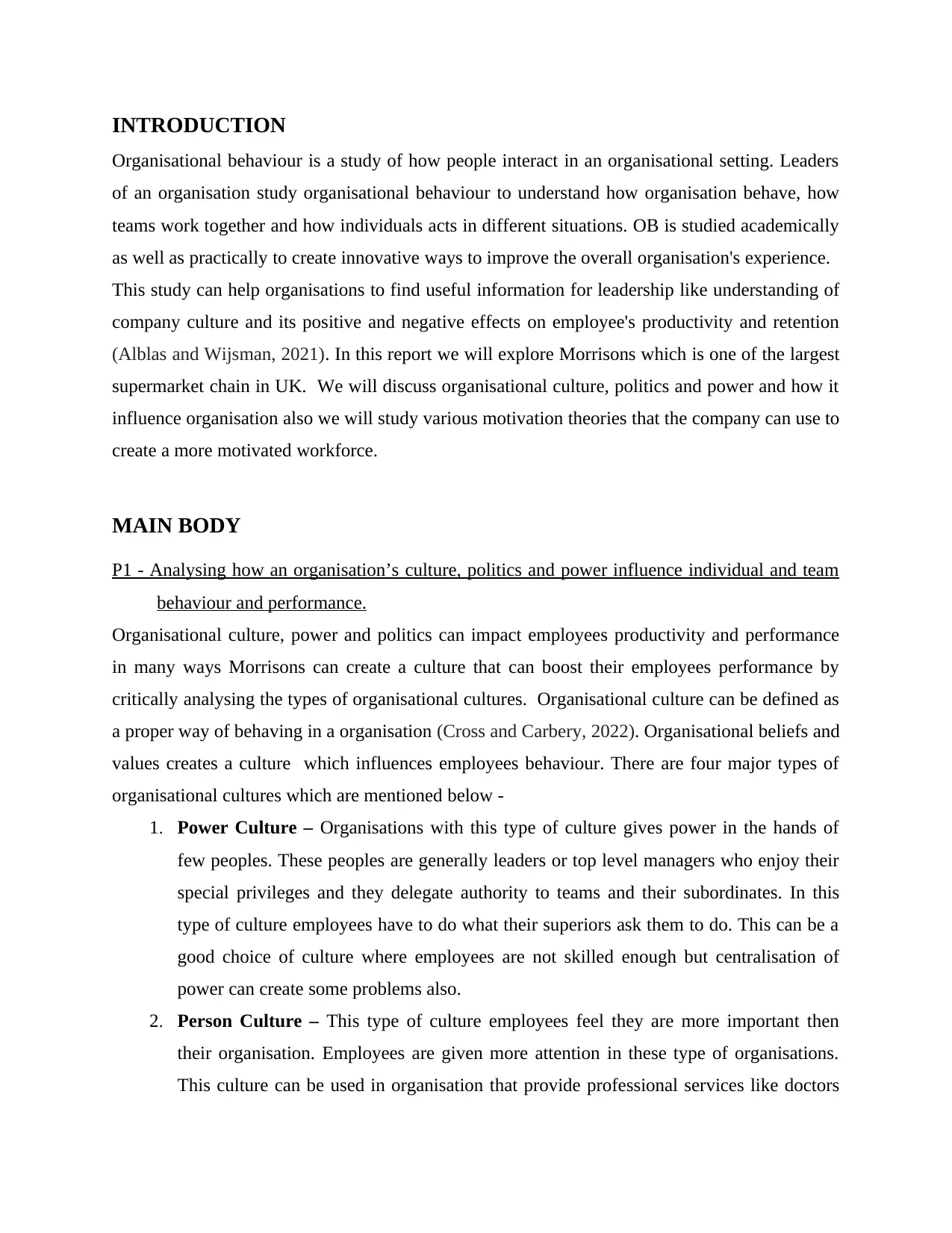
INTRODUCTION
Organisational behaviour is a study of how people interact in an organisational setting. Leaders
of an organisation study organisational behaviour to understand how organisation behave, how
teams work together and how individuals acts in different situations. OB is studied academically
as well as practically to create innovative ways to improve the overall organisation's experience.
This study can help organisations to find useful information for leadership like understanding of
company culture and its positive and negative effects on employee's productivity and retention
(Alblas and Wijsman, 2021). In this report we will explore Morrisons which is one of the largest
supermarket chain in UK. We will discuss organisational culture, politics and power and how it
influence organisation also we will study various motivation theories that the company can use to
create a more motivated workforce.
MAIN BODY
P1 - Analysing how an organisation’s culture, politics and power influence individual and team
behaviour and performance.
Organisational culture, power and politics can impact employees productivity and performance
in many ways Morrisons can create a culture that can boost their employees performance by
critically analysing the types of organisational cultures. Organisational culture can be defined as
a proper way of behaving in a organisation (Cross and Carbery, 2022). Organisational beliefs and
values creates a culture which influences employees behaviour. There are four major types of
organisational cultures which are mentioned below -
1. Power Culture – Organisations with this type of culture gives power in the hands of
few peoples. These peoples are generally leaders or top level managers who enjoy their
special privileges and they delegate authority to teams and their subordinates. In this
type of culture employees have to do what their superiors ask them to do. This can be a
good choice of culture where employees are not skilled enough but centralisation of
power can create some problems also.
2. Person Culture – This type of culture employees feel they are more important then
their organisation. Employees are given more attention in these type of organisations.
This culture can be used in organisation that provide professional services like doctors
Organisational behaviour is a study of how people interact in an organisational setting. Leaders
of an organisation study organisational behaviour to understand how organisation behave, how
teams work together and how individuals acts in different situations. OB is studied academically
as well as practically to create innovative ways to improve the overall organisation's experience.
This study can help organisations to find useful information for leadership like understanding of
company culture and its positive and negative effects on employee's productivity and retention
(Alblas and Wijsman, 2021). In this report we will explore Morrisons which is one of the largest
supermarket chain in UK. We will discuss organisational culture, politics and power and how it
influence organisation also we will study various motivation theories that the company can use to
create a more motivated workforce.
MAIN BODY
P1 - Analysing how an organisation’s culture, politics and power influence individual and team
behaviour and performance.
Organisational culture, power and politics can impact employees productivity and performance
in many ways Morrisons can create a culture that can boost their employees performance by
critically analysing the types of organisational cultures. Organisational culture can be defined as
a proper way of behaving in a organisation (Cross and Carbery, 2022). Organisational beliefs and
values creates a culture which influences employees behaviour. There are four major types of
organisational cultures which are mentioned below -
1. Power Culture – Organisations with this type of culture gives power in the hands of
few peoples. These peoples are generally leaders or top level managers who enjoy their
special privileges and they delegate authority to teams and their subordinates. In this
type of culture employees have to do what their superiors ask them to do. This can be a
good choice of culture where employees are not skilled enough but centralisation of
power can create some problems also.
2. Person Culture – This type of culture employees feel they are more important then
their organisation. Employees are given more attention in these type of organisations.
This culture can be used in organisation that provide professional services like doctors
⊘ This is a preview!⊘
Do you want full access?
Subscribe today to unlock all pages.

Trusted by 1+ million students worldwide
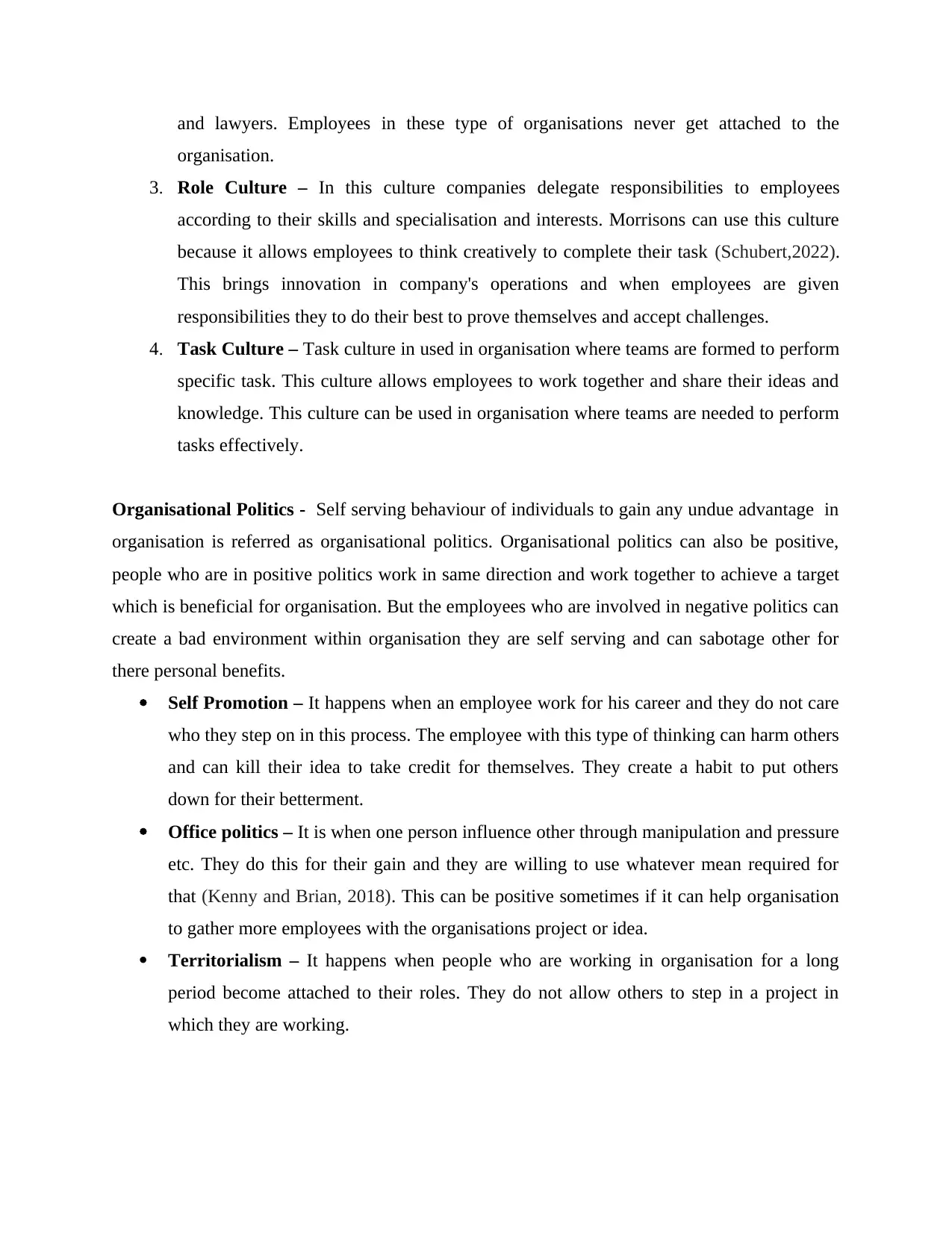
and lawyers. Employees in these type of organisations never get attached to the
organisation.
3. Role Culture – In this culture companies delegate responsibilities to employees
according to their skills and specialisation and interests. Morrisons can use this culture
because it allows employees to think creatively to complete their task (Schubert,2022).
This brings innovation in company's operations and when employees are given
responsibilities they to do their best to prove themselves and accept challenges.
4. Task Culture – Task culture in used in organisation where teams are formed to perform
specific task. This culture allows employees to work together and share their ideas and
knowledge. This culture can be used in organisation where teams are needed to perform
tasks effectively.
Organisational Politics - Self serving behaviour of individuals to gain any undue advantage in
organisation is referred as organisational politics. Organisational politics can also be positive,
people who are in positive politics work in same direction and work together to achieve a target
which is beneficial for organisation. But the employees who are involved in negative politics can
create a bad environment within organisation they are self serving and can sabotage other for
there personal benefits.
Self Promotion – It happens when an employee work for his career and they do not care
who they step on in this process. The employee with this type of thinking can harm others
and can kill their idea to take credit for themselves. They create a habit to put others
down for their betterment.
Office politics – It is when one person influence other through manipulation and pressure
etc. They do this for their gain and they are willing to use whatever mean required for
that (Kenny and Brian, 2018). This can be positive sometimes if it can help organisation
to gather more employees with the organisations project or idea.
Territorialism – It happens when people who are working in organisation for a long
period become attached to their roles. They do not allow others to step in a project in
which they are working.
organisation.
3. Role Culture – In this culture companies delegate responsibilities to employees
according to their skills and specialisation and interests. Morrisons can use this culture
because it allows employees to think creatively to complete their task (Schubert,2022).
This brings innovation in company's operations and when employees are given
responsibilities they to do their best to prove themselves and accept challenges.
4. Task Culture – Task culture in used in organisation where teams are formed to perform
specific task. This culture allows employees to work together and share their ideas and
knowledge. This culture can be used in organisation where teams are needed to perform
tasks effectively.
Organisational Politics - Self serving behaviour of individuals to gain any undue advantage in
organisation is referred as organisational politics. Organisational politics can also be positive,
people who are in positive politics work in same direction and work together to achieve a target
which is beneficial for organisation. But the employees who are involved in negative politics can
create a bad environment within organisation they are self serving and can sabotage other for
there personal benefits.
Self Promotion – It happens when an employee work for his career and they do not care
who they step on in this process. The employee with this type of thinking can harm others
and can kill their idea to take credit for themselves. They create a habit to put others
down for their betterment.
Office politics – It is when one person influence other through manipulation and pressure
etc. They do this for their gain and they are willing to use whatever mean required for
that (Kenny and Brian, 2018). This can be positive sometimes if it can help organisation
to gather more employees with the organisations project or idea.
Territorialism – It happens when people who are working in organisation for a long
period become attached to their roles. They do not allow others to step in a project in
which they are working.
Paraphrase This Document
Need a fresh take? Get an instant paraphrase of this document with our AI Paraphraser
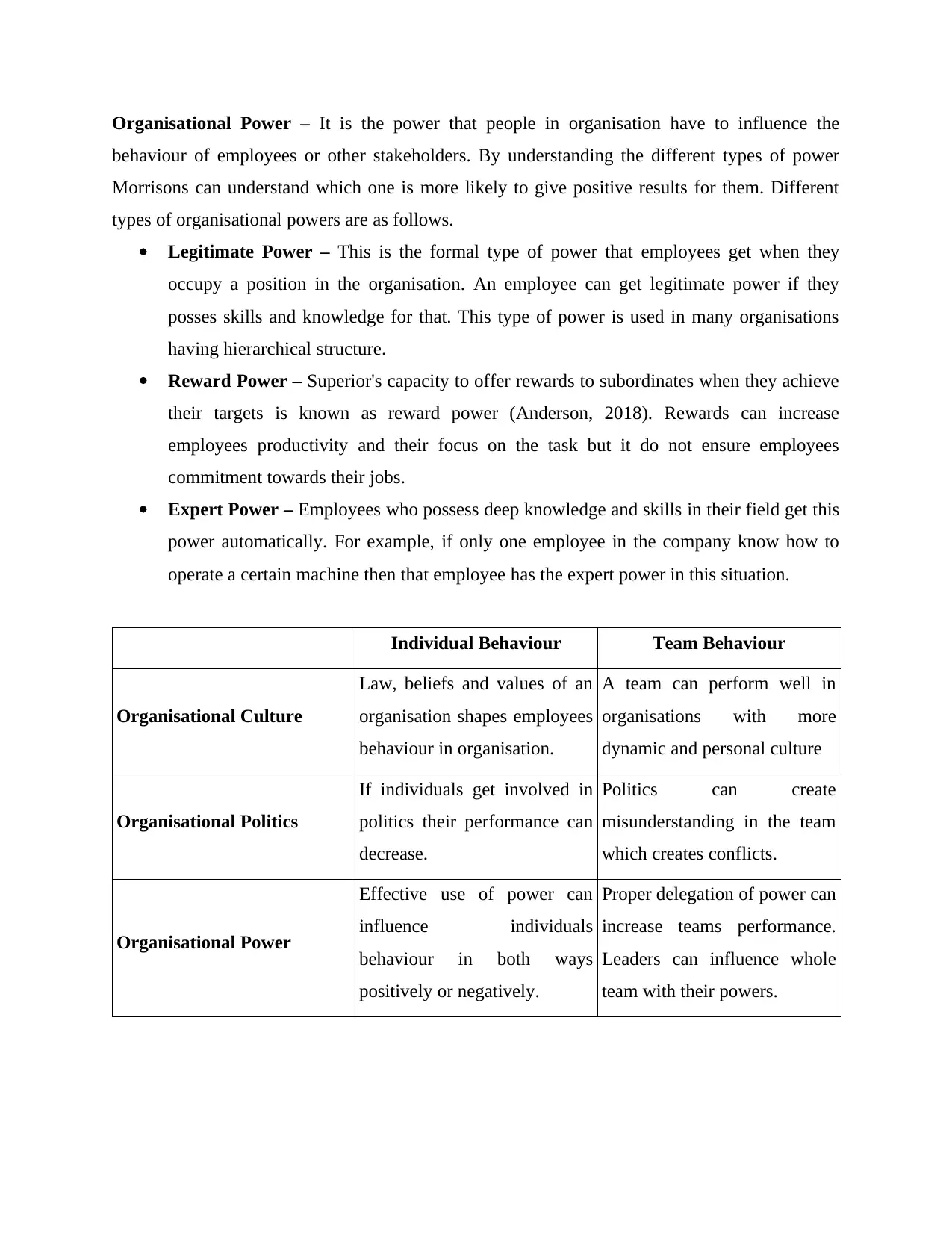
Organisational Power – It is the power that people in organisation have to influence the
behaviour of employees or other stakeholders. By understanding the different types of power
Morrisons can understand which one is more likely to give positive results for them. Different
types of organisational powers are as follows.
Legitimate Power – This is the formal type of power that employees get when they
occupy a position in the organisation. An employee can get legitimate power if they
posses skills and knowledge for that. This type of power is used in many organisations
having hierarchical structure.
Reward Power – Superior's capacity to offer rewards to subordinates when they achieve
their targets is known as reward power (Anderson, 2018). Rewards can increase
employees productivity and their focus on the task but it do not ensure employees
commitment towards their jobs.
Expert Power – Employees who possess deep knowledge and skills in their field get this
power automatically. For example, if only one employee in the company know how to
operate a certain machine then that employee has the expert power in this situation.
Individual Behaviour Team Behaviour
Organisational Culture
Law, beliefs and values of an
organisation shapes employees
behaviour in organisation.
A team can perform well in
organisations with more
dynamic and personal culture
Organisational Politics
If individuals get involved in
politics their performance can
decrease.
Politics can create
misunderstanding in the team
which creates conflicts.
Organisational Power
Effective use of power can
influence individuals
behaviour in both ways
positively or negatively.
Proper delegation of power can
increase teams performance.
Leaders can influence whole
team with their powers.
behaviour of employees or other stakeholders. By understanding the different types of power
Morrisons can understand which one is more likely to give positive results for them. Different
types of organisational powers are as follows.
Legitimate Power – This is the formal type of power that employees get when they
occupy a position in the organisation. An employee can get legitimate power if they
posses skills and knowledge for that. This type of power is used in many organisations
having hierarchical structure.
Reward Power – Superior's capacity to offer rewards to subordinates when they achieve
their targets is known as reward power (Anderson, 2018). Rewards can increase
employees productivity and their focus on the task but it do not ensure employees
commitment towards their jobs.
Expert Power – Employees who possess deep knowledge and skills in their field get this
power automatically. For example, if only one employee in the company know how to
operate a certain machine then that employee has the expert power in this situation.
Individual Behaviour Team Behaviour
Organisational Culture
Law, beliefs and values of an
organisation shapes employees
behaviour in organisation.
A team can perform well in
organisations with more
dynamic and personal culture
Organisational Politics
If individuals get involved in
politics their performance can
decrease.
Politics can create
misunderstanding in the team
which creates conflicts.
Organisational Power
Effective use of power can
influence individuals
behaviour in both ways
positively or negatively.
Proper delegation of power can
increase teams performance.
Leaders can influence whole
team with their powers.
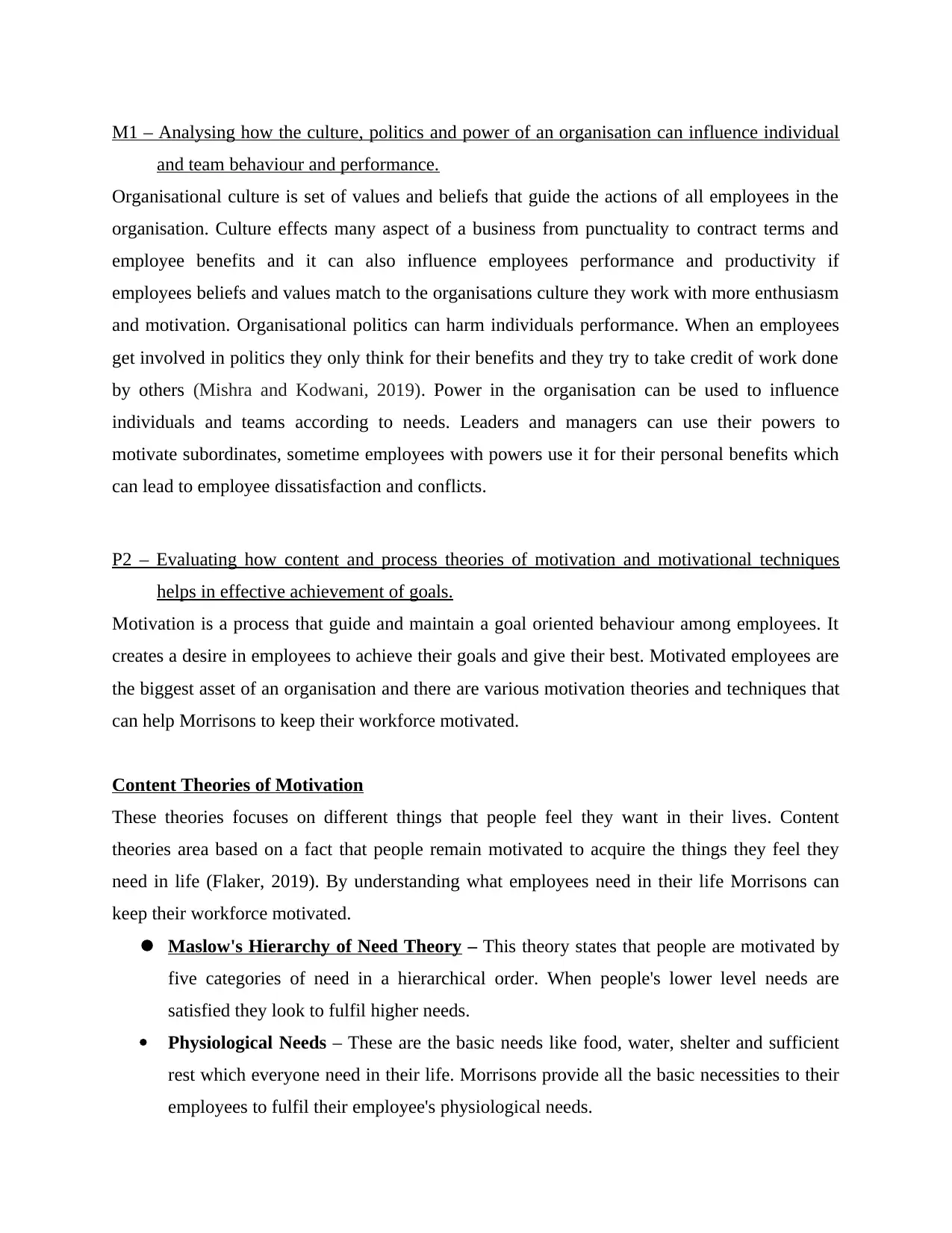
M1 – Analysing how the culture, politics and power of an organisation can influence individual
and team behaviour and performance.
Organisational culture is set of values and beliefs that guide the actions of all employees in the
organisation. Culture effects many aspect of a business from punctuality to contract terms and
employee benefits and it can also influence employees performance and productivity if
employees beliefs and values match to the organisations culture they work with more enthusiasm
and motivation. Organisational politics can harm individuals performance. When an employees
get involved in politics they only think for their benefits and they try to take credit of work done
by others (Mishra and Kodwani, 2019). Power in the organisation can be used to influence
individuals and teams according to needs. Leaders and managers can use their powers to
motivate subordinates, sometime employees with powers use it for their personal benefits which
can lead to employee dissatisfaction and conflicts.
P2 – Evaluating how content and process theories of motivation and motivational techniques
helps in effective achievement of goals.
Motivation is a process that guide and maintain a goal oriented behaviour among employees. It
creates a desire in employees to achieve their goals and give their best. Motivated employees are
the biggest asset of an organisation and there are various motivation theories and techniques that
can help Morrisons to keep their workforce motivated.
Content Theories of Motivation
These theories focuses on different things that people feel they want in their lives. Content
theories area based on a fact that people remain motivated to acquire the things they feel they
need in life (Flaker, 2019). By understanding what employees need in their life Morrisons can
keep their workforce motivated.
Maslow's Hierarchy of Need Theory – This theory states that people are motivated by
five categories of need in a hierarchical order. When people's lower level needs are
satisfied they look to fulfil higher needs.
Physiological Needs – These are the basic needs like food, water, shelter and sufficient
rest which everyone need in their life. Morrisons provide all the basic necessities to their
employees to fulfil their employee's physiological needs.
and team behaviour and performance.
Organisational culture is set of values and beliefs that guide the actions of all employees in the
organisation. Culture effects many aspect of a business from punctuality to contract terms and
employee benefits and it can also influence employees performance and productivity if
employees beliefs and values match to the organisations culture they work with more enthusiasm
and motivation. Organisational politics can harm individuals performance. When an employees
get involved in politics they only think for their benefits and they try to take credit of work done
by others (Mishra and Kodwani, 2019). Power in the organisation can be used to influence
individuals and teams according to needs. Leaders and managers can use their powers to
motivate subordinates, sometime employees with powers use it for their personal benefits which
can lead to employee dissatisfaction and conflicts.
P2 – Evaluating how content and process theories of motivation and motivational techniques
helps in effective achievement of goals.
Motivation is a process that guide and maintain a goal oriented behaviour among employees. It
creates a desire in employees to achieve their goals and give their best. Motivated employees are
the biggest asset of an organisation and there are various motivation theories and techniques that
can help Morrisons to keep their workforce motivated.
Content Theories of Motivation
These theories focuses on different things that people feel they want in their lives. Content
theories area based on a fact that people remain motivated to acquire the things they feel they
need in life (Flaker, 2019). By understanding what employees need in their life Morrisons can
keep their workforce motivated.
Maslow's Hierarchy of Need Theory – This theory states that people are motivated by
five categories of need in a hierarchical order. When people's lower level needs are
satisfied they look to fulfil higher needs.
Physiological Needs – These are the basic needs like food, water, shelter and sufficient
rest which everyone need in their life. Morrisons provide all the basic necessities to their
employees to fulfil their employee's physiological needs.
⊘ This is a preview!⊘
Do you want full access?
Subscribe today to unlock all pages.

Trusted by 1+ million students worldwide
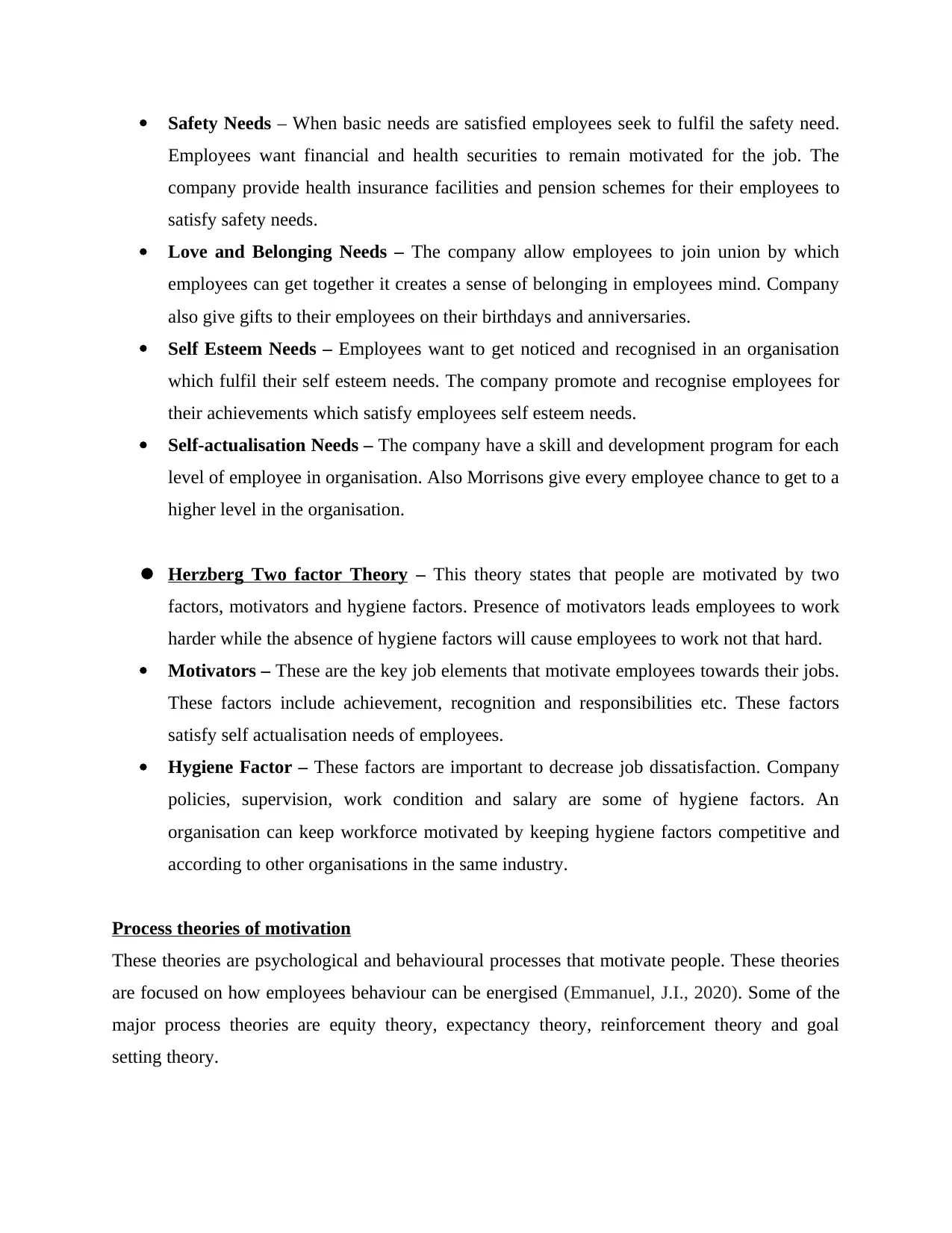
Safety Needs – When basic needs are satisfied employees seek to fulfil the safety need.
Employees want financial and health securities to remain motivated for the job. The
company provide health insurance facilities and pension schemes for their employees to
satisfy safety needs.
Love and Belonging Needs – The company allow employees to join union by which
employees can get together it creates a sense of belonging in employees mind. Company
also give gifts to their employees on their birthdays and anniversaries.
Self Esteem Needs – Employees want to get noticed and recognised in an organisation
which fulfil their self esteem needs. The company promote and recognise employees for
their achievements which satisfy employees self esteem needs.
Self-actualisation Needs – The company have a skill and development program for each
level of employee in organisation. Also Morrisons give every employee chance to get to a
higher level in the organisation.
Herzberg Two factor Theory – This theory states that people are motivated by two
factors, motivators and hygiene factors. Presence of motivators leads employees to work
harder while the absence of hygiene factors will cause employees to work not that hard.
Motivators – These are the key job elements that motivate employees towards their jobs.
These factors include achievement, recognition and responsibilities etc. These factors
satisfy self actualisation needs of employees.
Hygiene Factor – These factors are important to decrease job dissatisfaction. Company
policies, supervision, work condition and salary are some of hygiene factors. An
organisation can keep workforce motivated by keeping hygiene factors competitive and
according to other organisations in the same industry.
Process theories of motivation
These theories are psychological and behavioural processes that motivate people. These theories
are focused on how employees behaviour can be energised (Emmanuel, J.I., 2020). Some of the
major process theories are equity theory, expectancy theory, reinforcement theory and goal
setting theory.
Employees want financial and health securities to remain motivated for the job. The
company provide health insurance facilities and pension schemes for their employees to
satisfy safety needs.
Love and Belonging Needs – The company allow employees to join union by which
employees can get together it creates a sense of belonging in employees mind. Company
also give gifts to their employees on their birthdays and anniversaries.
Self Esteem Needs – Employees want to get noticed and recognised in an organisation
which fulfil their self esteem needs. The company promote and recognise employees for
their achievements which satisfy employees self esteem needs.
Self-actualisation Needs – The company have a skill and development program for each
level of employee in organisation. Also Morrisons give every employee chance to get to a
higher level in the organisation.
Herzberg Two factor Theory – This theory states that people are motivated by two
factors, motivators and hygiene factors. Presence of motivators leads employees to work
harder while the absence of hygiene factors will cause employees to work not that hard.
Motivators – These are the key job elements that motivate employees towards their jobs.
These factors include achievement, recognition and responsibilities etc. These factors
satisfy self actualisation needs of employees.
Hygiene Factor – These factors are important to decrease job dissatisfaction. Company
policies, supervision, work condition and salary are some of hygiene factors. An
organisation can keep workforce motivated by keeping hygiene factors competitive and
according to other organisations in the same industry.
Process theories of motivation
These theories are psychological and behavioural processes that motivate people. These theories
are focused on how employees behaviour can be energised (Emmanuel, J.I., 2020). Some of the
major process theories are equity theory, expectancy theory, reinforcement theory and goal
setting theory.
Paraphrase This Document
Need a fresh take? Get an instant paraphrase of this document with our AI Paraphraser
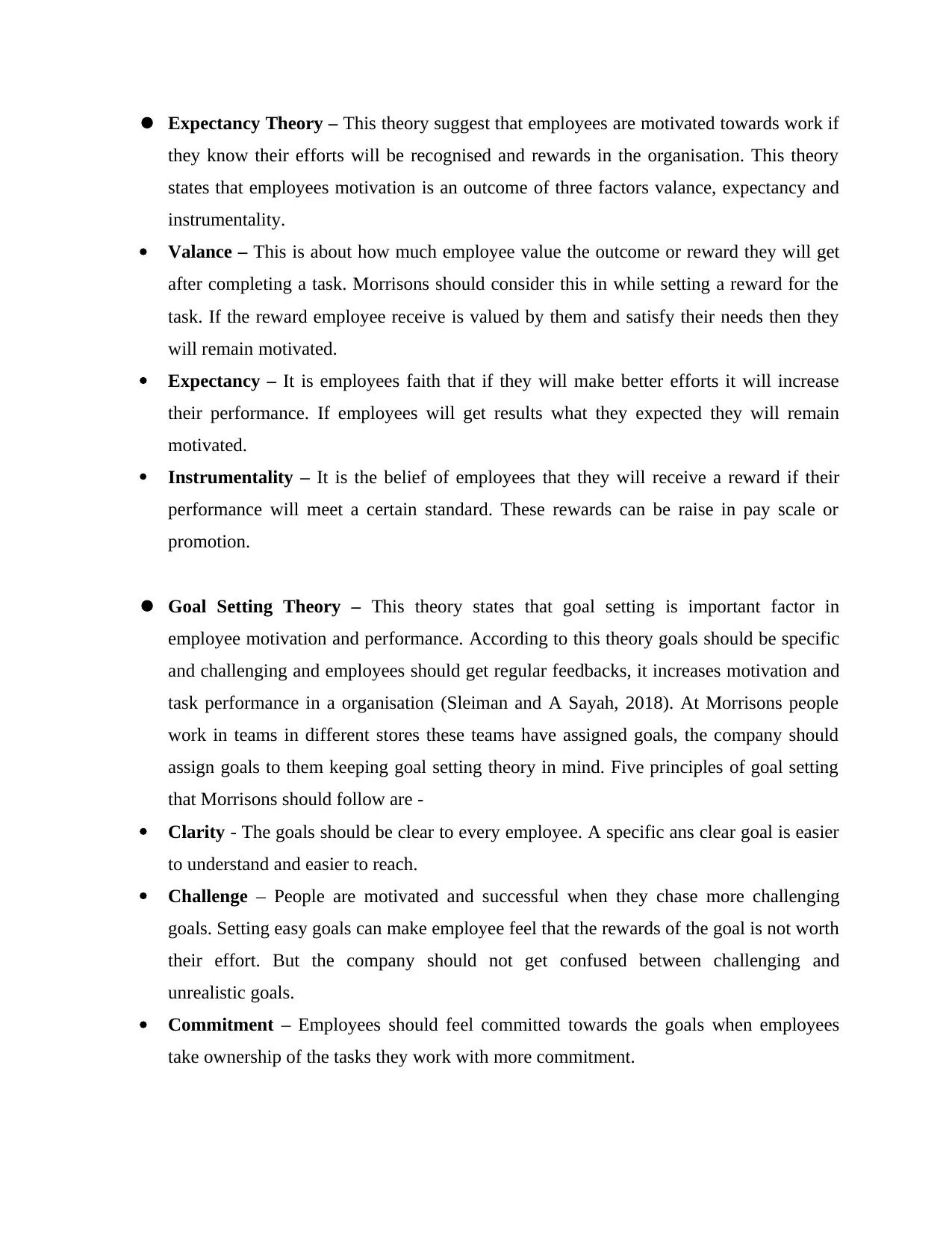
Expectancy Theory – This theory suggest that employees are motivated towards work if
they know their efforts will be recognised and rewards in the organisation. This theory
states that employees motivation is an outcome of three factors valance, expectancy and
instrumentality.
Valance – This is about how much employee value the outcome or reward they will get
after completing a task. Morrisons should consider this in while setting a reward for the
task. If the reward employee receive is valued by them and satisfy their needs then they
will remain motivated.
Expectancy – It is employees faith that if they will make better efforts it will increase
their performance. If employees will get results what they expected they will remain
motivated.
Instrumentality – It is the belief of employees that they will receive a reward if their
performance will meet a certain standard. These rewards can be raise in pay scale or
promotion.
Goal Setting Theory – This theory states that goal setting is important factor in
employee motivation and performance. According to this theory goals should be specific
and challenging and employees should get regular feedbacks, it increases motivation and
task performance in a organisation (Sleiman and A Sayah, 2018). At Morrisons people
work in teams in different stores these teams have assigned goals, the company should
assign goals to them keeping goal setting theory in mind. Five principles of goal setting
that Morrisons should follow are -
Clarity - The goals should be clear to every employee. A specific ans clear goal is easier
to understand and easier to reach.
Challenge – People are motivated and successful when they chase more challenging
goals. Setting easy goals can make employee feel that the rewards of the goal is not worth
their effort. But the company should not get confused between challenging and
unrealistic goals.
Commitment – Employees should feel committed towards the goals when employees
take ownership of the tasks they work with more commitment.
they know their efforts will be recognised and rewards in the organisation. This theory
states that employees motivation is an outcome of three factors valance, expectancy and
instrumentality.
Valance – This is about how much employee value the outcome or reward they will get
after completing a task. Morrisons should consider this in while setting a reward for the
task. If the reward employee receive is valued by them and satisfy their needs then they
will remain motivated.
Expectancy – It is employees faith that if they will make better efforts it will increase
their performance. If employees will get results what they expected they will remain
motivated.
Instrumentality – It is the belief of employees that they will receive a reward if their
performance will meet a certain standard. These rewards can be raise in pay scale or
promotion.
Goal Setting Theory – This theory states that goal setting is important factor in
employee motivation and performance. According to this theory goals should be specific
and challenging and employees should get regular feedbacks, it increases motivation and
task performance in a organisation (Sleiman and A Sayah, 2018). At Morrisons people
work in teams in different stores these teams have assigned goals, the company should
assign goals to them keeping goal setting theory in mind. Five principles of goal setting
that Morrisons should follow are -
Clarity - The goals should be clear to every employee. A specific ans clear goal is easier
to understand and easier to reach.
Challenge – People are motivated and successful when they chase more challenging
goals. Setting easy goals can make employee feel that the rewards of the goal is not worth
their effort. But the company should not get confused between challenging and
unrealistic goals.
Commitment – Employees should feel committed towards the goals when employees
take ownership of the tasks they work with more commitment.
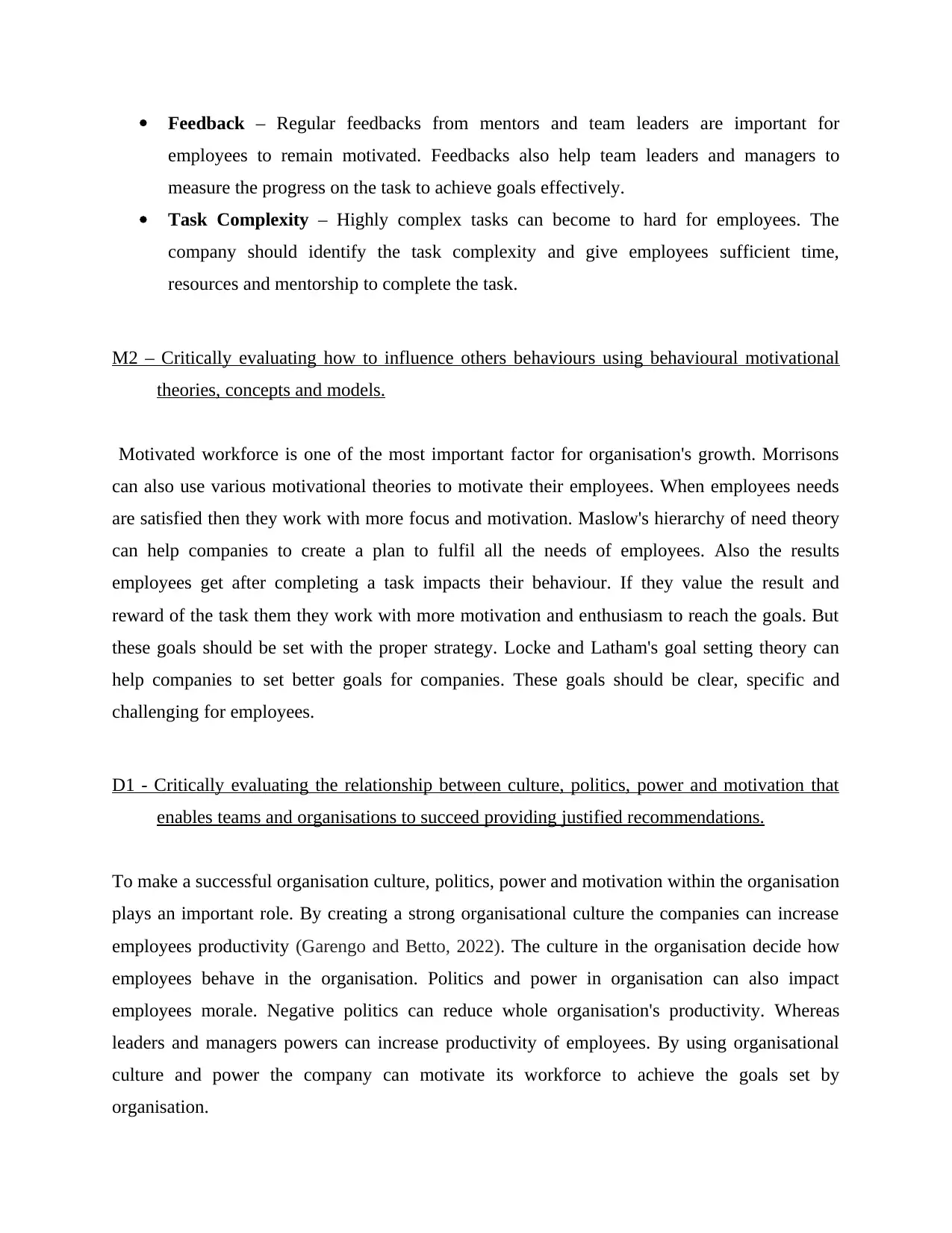
Feedback – Regular feedbacks from mentors and team leaders are important for
employees to remain motivated. Feedbacks also help team leaders and managers to
measure the progress on the task to achieve goals effectively.
Task Complexity – Highly complex tasks can become to hard for employees. The
company should identify the task complexity and give employees sufficient time,
resources and mentorship to complete the task.
M2 – Critically evaluating how to influence others behaviours using behavioural motivational
theories, concepts and models.
Motivated workforce is one of the most important factor for organisation's growth. Morrisons
can also use various motivational theories to motivate their employees. When employees needs
are satisfied then they work with more focus and motivation. Maslow's hierarchy of need theory
can help companies to create a plan to fulfil all the needs of employees. Also the results
employees get after completing a task impacts their behaviour. If they value the result and
reward of the task them they work with more motivation and enthusiasm to reach the goals. But
these goals should be set with the proper strategy. Locke and Latham's goal setting theory can
help companies to set better goals for companies. These goals should be clear, specific and
challenging for employees.
D1 - Critically evaluating the relationship between culture, politics, power and motivation that
enables teams and organisations to succeed providing justified recommendations.
To make a successful organisation culture, politics, power and motivation within the organisation
plays an important role. By creating a strong organisational culture the companies can increase
employees productivity (Garengo and Betto, 2022). The culture in the organisation decide how
employees behave in the organisation. Politics and power in organisation can also impact
employees morale. Negative politics can reduce whole organisation's productivity. Whereas
leaders and managers powers can increase productivity of employees. By using organisational
culture and power the company can motivate its workforce to achieve the goals set by
organisation.
employees to remain motivated. Feedbacks also help team leaders and managers to
measure the progress on the task to achieve goals effectively.
Task Complexity – Highly complex tasks can become to hard for employees. The
company should identify the task complexity and give employees sufficient time,
resources and mentorship to complete the task.
M2 – Critically evaluating how to influence others behaviours using behavioural motivational
theories, concepts and models.
Motivated workforce is one of the most important factor for organisation's growth. Morrisons
can also use various motivational theories to motivate their employees. When employees needs
are satisfied then they work with more focus and motivation. Maslow's hierarchy of need theory
can help companies to create a plan to fulfil all the needs of employees. Also the results
employees get after completing a task impacts their behaviour. If they value the result and
reward of the task them they work with more motivation and enthusiasm to reach the goals. But
these goals should be set with the proper strategy. Locke and Latham's goal setting theory can
help companies to set better goals for companies. These goals should be clear, specific and
challenging for employees.
D1 - Critically evaluating the relationship between culture, politics, power and motivation that
enables teams and organisations to succeed providing justified recommendations.
To make a successful organisation culture, politics, power and motivation within the organisation
plays an important role. By creating a strong organisational culture the companies can increase
employees productivity (Garengo and Betto, 2022). The culture in the organisation decide how
employees behave in the organisation. Politics and power in organisation can also impact
employees morale. Negative politics can reduce whole organisation's productivity. Whereas
leaders and managers powers can increase productivity of employees. By using organisational
culture and power the company can motivate its workforce to achieve the goals set by
organisation.
⊘ This is a preview!⊘
Do you want full access?
Subscribe today to unlock all pages.

Trusted by 1+ million students worldwide
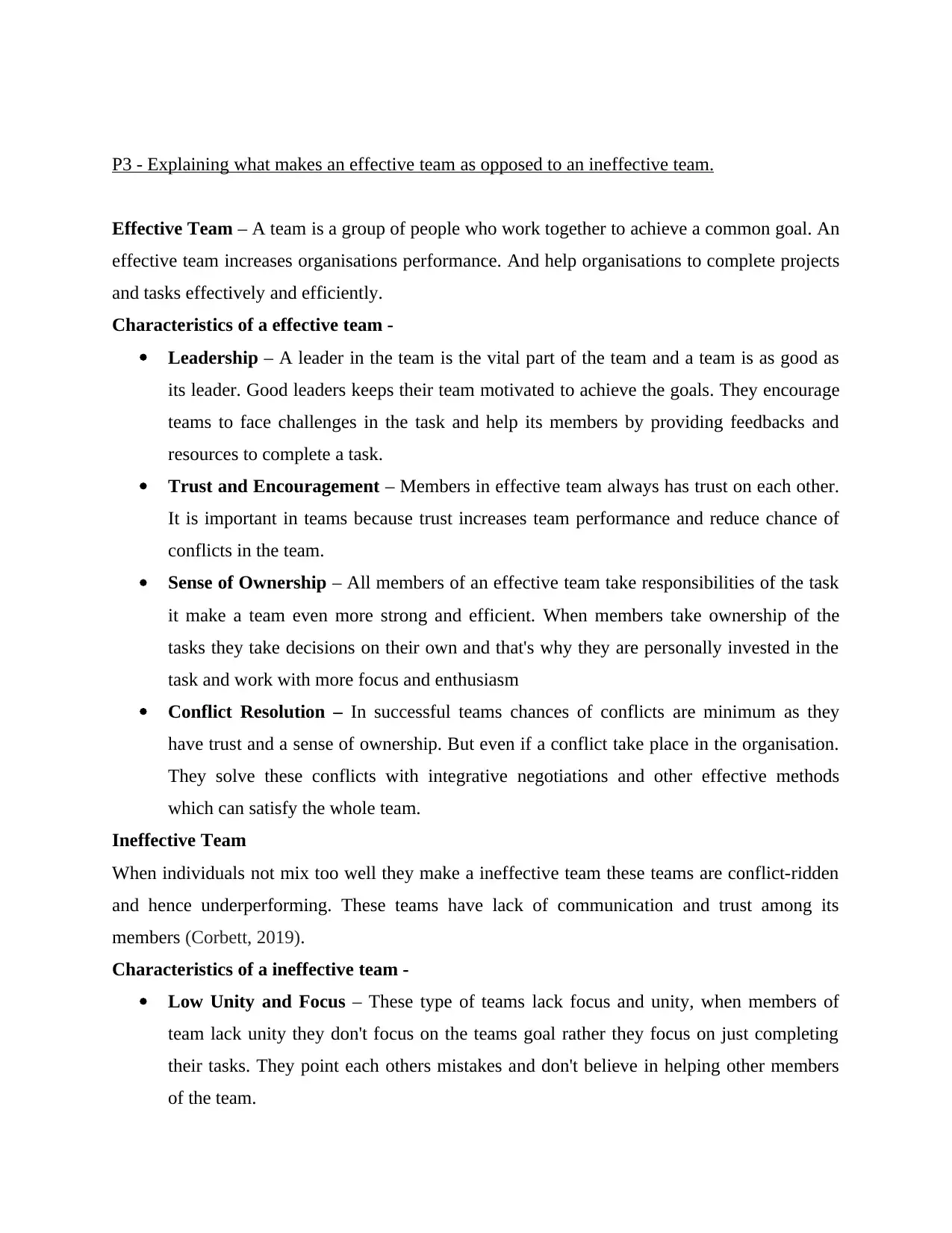
P3 - Explaining what makes an effective team as opposed to an ineffective team.
Effective Team – A team is a group of people who work together to achieve a common goal. An
effective team increases organisations performance. And help organisations to complete projects
and tasks effectively and efficiently.
Characteristics of a effective team -
Leadership – A leader in the team is the vital part of the team and a team is as good as
its leader. Good leaders keeps their team motivated to achieve the goals. They encourage
teams to face challenges in the task and help its members by providing feedbacks and
resources to complete a task.
Trust and Encouragement – Members in effective team always has trust on each other.
It is important in teams because trust increases team performance and reduce chance of
conflicts in the team.
Sense of Ownership – All members of an effective team take responsibilities of the task
it make a team even more strong and efficient. When members take ownership of the
tasks they take decisions on their own and that's why they are personally invested in the
task and work with more focus and enthusiasm
Conflict Resolution – In successful teams chances of conflicts are minimum as they
have trust and a sense of ownership. But even if a conflict take place in the organisation.
They solve these conflicts with integrative negotiations and other effective methods
which can satisfy the whole team.
Ineffective Team
When individuals not mix too well they make a ineffective team these teams are conflict-ridden
and hence underperforming. These teams have lack of communication and trust among its
members (Corbett, 2019).
Characteristics of a ineffective team -
Low Unity and Focus – These type of teams lack focus and unity, when members of
team lack unity they don't focus on the teams goal rather they focus on just completing
their tasks. They point each others mistakes and don't believe in helping other members
of the team.
Effective Team – A team is a group of people who work together to achieve a common goal. An
effective team increases organisations performance. And help organisations to complete projects
and tasks effectively and efficiently.
Characteristics of a effective team -
Leadership – A leader in the team is the vital part of the team and a team is as good as
its leader. Good leaders keeps their team motivated to achieve the goals. They encourage
teams to face challenges in the task and help its members by providing feedbacks and
resources to complete a task.
Trust and Encouragement – Members in effective team always has trust on each other.
It is important in teams because trust increases team performance and reduce chance of
conflicts in the team.
Sense of Ownership – All members of an effective team take responsibilities of the task
it make a team even more strong and efficient. When members take ownership of the
tasks they take decisions on their own and that's why they are personally invested in the
task and work with more focus and enthusiasm
Conflict Resolution – In successful teams chances of conflicts are minimum as they
have trust and a sense of ownership. But even if a conflict take place in the organisation.
They solve these conflicts with integrative negotiations and other effective methods
which can satisfy the whole team.
Ineffective Team
When individuals not mix too well they make a ineffective team these teams are conflict-ridden
and hence underperforming. These teams have lack of communication and trust among its
members (Corbett, 2019).
Characteristics of a ineffective team -
Low Unity and Focus – These type of teams lack focus and unity, when members of
team lack unity they don't focus on the teams goal rather they focus on just completing
their tasks. They point each others mistakes and don't believe in helping other members
of the team.
Paraphrase This Document
Need a fresh take? Get an instant paraphrase of this document with our AI Paraphraser
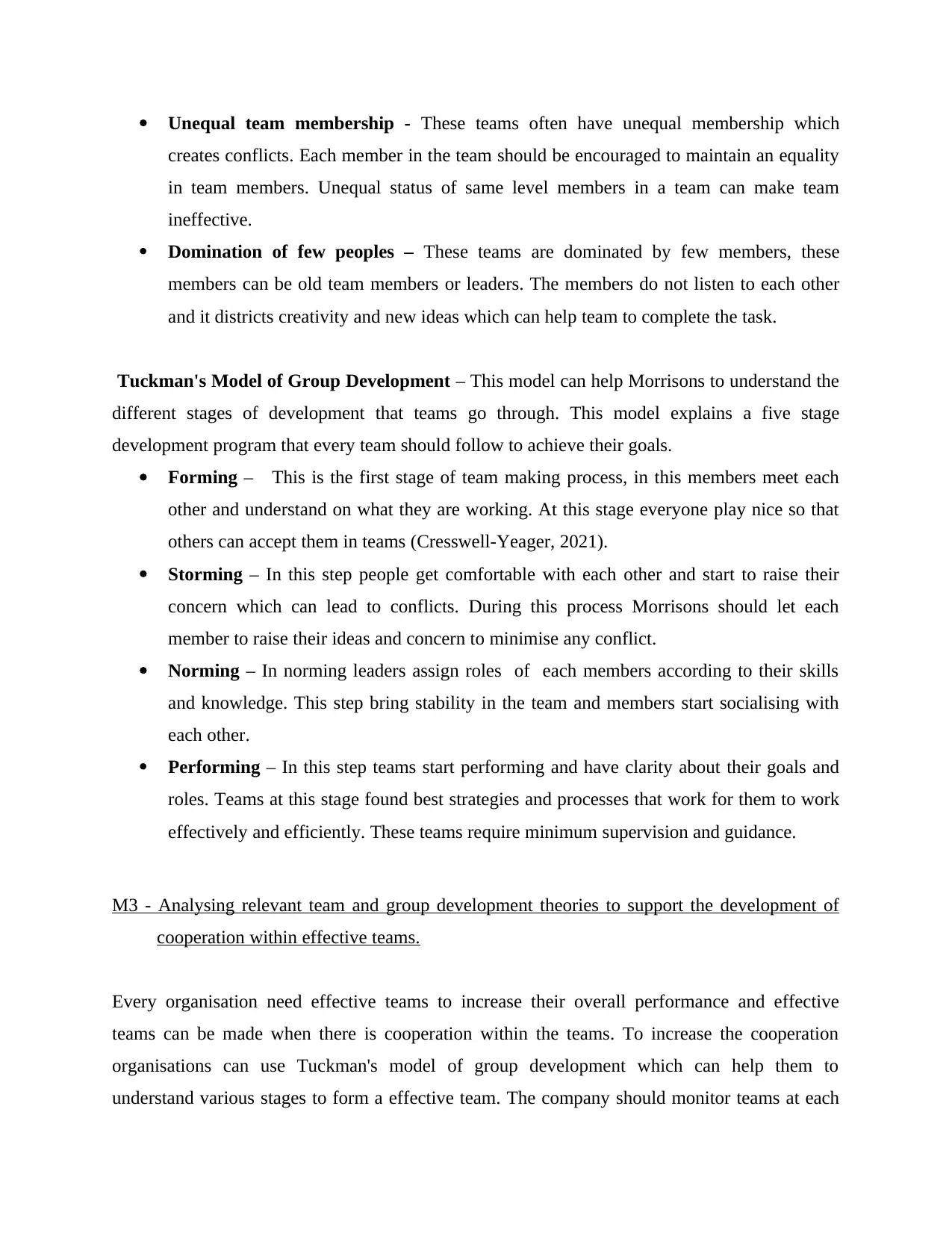
Unequal team membership - These teams often have unequal membership which
creates conflicts. Each member in the team should be encouraged to maintain an equality
in team members. Unequal status of same level members in a team can make team
ineffective.
Domination of few peoples – These teams are dominated by few members, these
members can be old team members or leaders. The members do not listen to each other
and it districts creativity and new ideas which can help team to complete the task.
Tuckman's Model of Group Development – This model can help Morrisons to understand the
different stages of development that teams go through. This model explains a five stage
development program that every team should follow to achieve their goals.
Forming – This is the first stage of team making process, in this members meet each
other and understand on what they are working. At this stage everyone play nice so that
others can accept them in teams (Cresswell-Yeager, 2021).
Storming – In this step people get comfortable with each other and start to raise their
concern which can lead to conflicts. During this process Morrisons should let each
member to raise their ideas and concern to minimise any conflict.
Norming – In norming leaders assign roles of each members according to their skills
and knowledge. This step bring stability in the team and members start socialising with
each other.
Performing – In this step teams start performing and have clarity about their goals and
roles. Teams at this stage found best strategies and processes that work for them to work
effectively and efficiently. These teams require minimum supervision and guidance.
M3 - Analysing relevant team and group development theories to support the development of
cooperation within effective teams.
Every organisation need effective teams to increase their overall performance and effective
teams can be made when there is cooperation within the teams. To increase the cooperation
organisations can use Tuckman's model of group development which can help them to
understand various stages to form a effective team. The company should monitor teams at each
creates conflicts. Each member in the team should be encouraged to maintain an equality
in team members. Unequal status of same level members in a team can make team
ineffective.
Domination of few peoples – These teams are dominated by few members, these
members can be old team members or leaders. The members do not listen to each other
and it districts creativity and new ideas which can help team to complete the task.
Tuckman's Model of Group Development – This model can help Morrisons to understand the
different stages of development that teams go through. This model explains a five stage
development program that every team should follow to achieve their goals.
Forming – This is the first stage of team making process, in this members meet each
other and understand on what they are working. At this stage everyone play nice so that
others can accept them in teams (Cresswell-Yeager, 2021).
Storming – In this step people get comfortable with each other and start to raise their
concern which can lead to conflicts. During this process Morrisons should let each
member to raise their ideas and concern to minimise any conflict.
Norming – In norming leaders assign roles of each members according to their skills
and knowledge. This step bring stability in the team and members start socialising with
each other.
Performing – In this step teams start performing and have clarity about their goals and
roles. Teams at this stage found best strategies and processes that work for them to work
effectively and efficiently. These teams require minimum supervision and guidance.
M3 - Analysing relevant team and group development theories to support the development of
cooperation within effective teams.
Every organisation need effective teams to increase their overall performance and effective
teams can be made when there is cooperation within the teams. To increase the cooperation
organisations can use Tuckman's model of group development which can help them to
understand various stages to form a effective team. The company should monitor teams at each
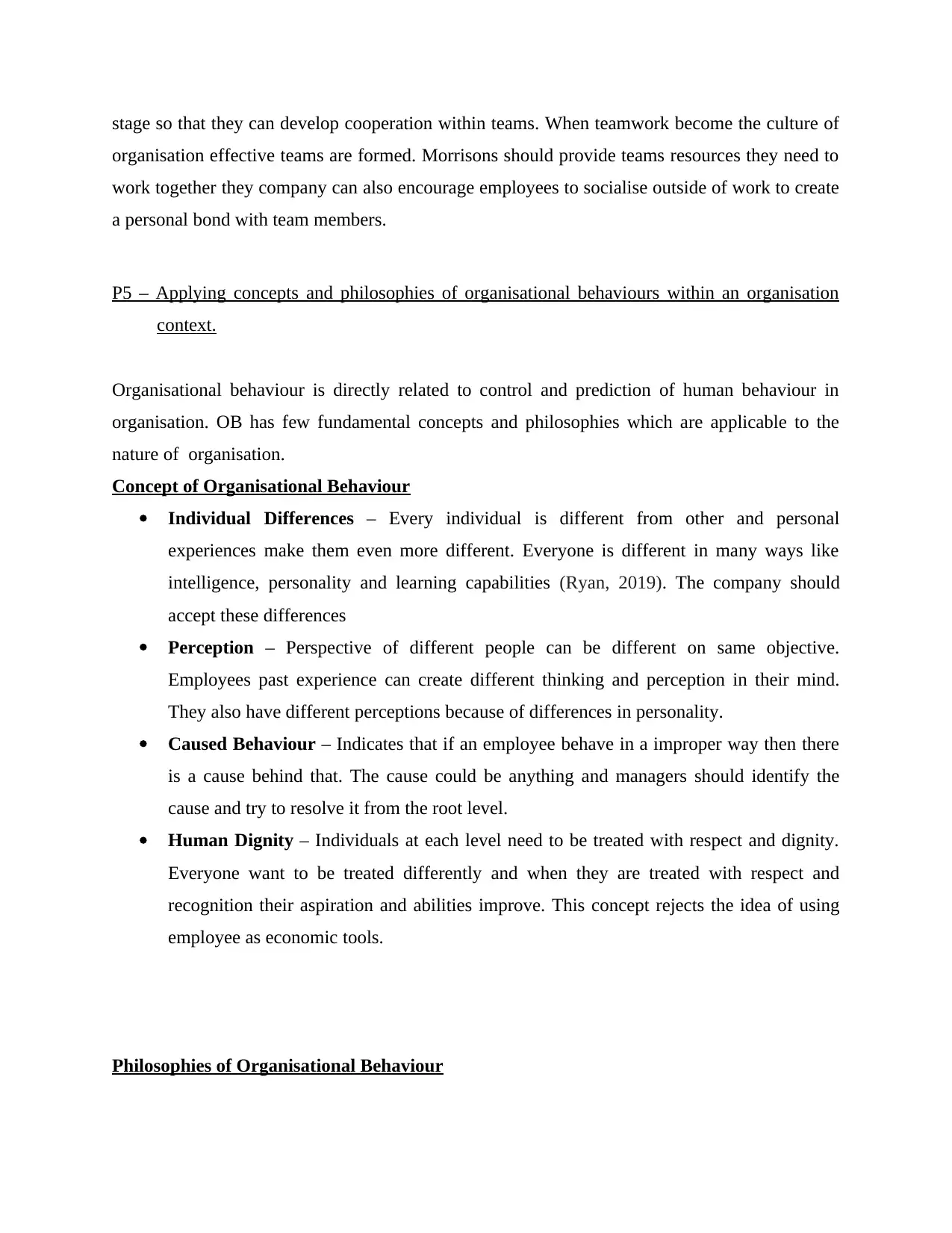
stage so that they can develop cooperation within teams. When teamwork become the culture of
organisation effective teams are formed. Morrisons should provide teams resources they need to
work together they company can also encourage employees to socialise outside of work to create
a personal bond with team members.
P5 – Applying concepts and philosophies of organisational behaviours within an organisation
context.
Organisational behaviour is directly related to control and prediction of human behaviour in
organisation. OB has few fundamental concepts and philosophies which are applicable to the
nature of organisation.
Concept of Organisational Behaviour
Individual Differences – Every individual is different from other and personal
experiences make them even more different. Everyone is different in many ways like
intelligence, personality and learning capabilities (Ryan, 2019). The company should
accept these differences
Perception – Perspective of different people can be different on same objective.
Employees past experience can create different thinking and perception in their mind.
They also have different perceptions because of differences in personality.
Caused Behaviour – Indicates that if an employee behave in a improper way then there
is a cause behind that. The cause could be anything and managers should identify the
cause and try to resolve it from the root level.
Human Dignity – Individuals at each level need to be treated with respect and dignity.
Everyone want to be treated differently and when they are treated with respect and
recognition their aspiration and abilities improve. This concept rejects the idea of using
employee as economic tools.
Philosophies of Organisational Behaviour
organisation effective teams are formed. Morrisons should provide teams resources they need to
work together they company can also encourage employees to socialise outside of work to create
a personal bond with team members.
P5 – Applying concepts and philosophies of organisational behaviours within an organisation
context.
Organisational behaviour is directly related to control and prediction of human behaviour in
organisation. OB has few fundamental concepts and philosophies which are applicable to the
nature of organisation.
Concept of Organisational Behaviour
Individual Differences – Every individual is different from other and personal
experiences make them even more different. Everyone is different in many ways like
intelligence, personality and learning capabilities (Ryan, 2019). The company should
accept these differences
Perception – Perspective of different people can be different on same objective.
Employees past experience can create different thinking and perception in their mind.
They also have different perceptions because of differences in personality.
Caused Behaviour – Indicates that if an employee behave in a improper way then there
is a cause behind that. The cause could be anything and managers should identify the
cause and try to resolve it from the root level.
Human Dignity – Individuals at each level need to be treated with respect and dignity.
Everyone want to be treated differently and when they are treated with respect and
recognition their aspiration and abilities improve. This concept rejects the idea of using
employee as economic tools.
Philosophies of Organisational Behaviour
⊘ This is a preview!⊘
Do you want full access?
Subscribe today to unlock all pages.

Trusted by 1+ million students worldwide
1 out of 15
Related Documents
Your All-in-One AI-Powered Toolkit for Academic Success.
+13062052269
info@desklib.com
Available 24*7 on WhatsApp / Email
![[object Object]](/_next/static/media/star-bottom.7253800d.svg)
Unlock your academic potential
Copyright © 2020–2025 A2Z Services. All Rights Reserved. Developed and managed by ZUCOL.




